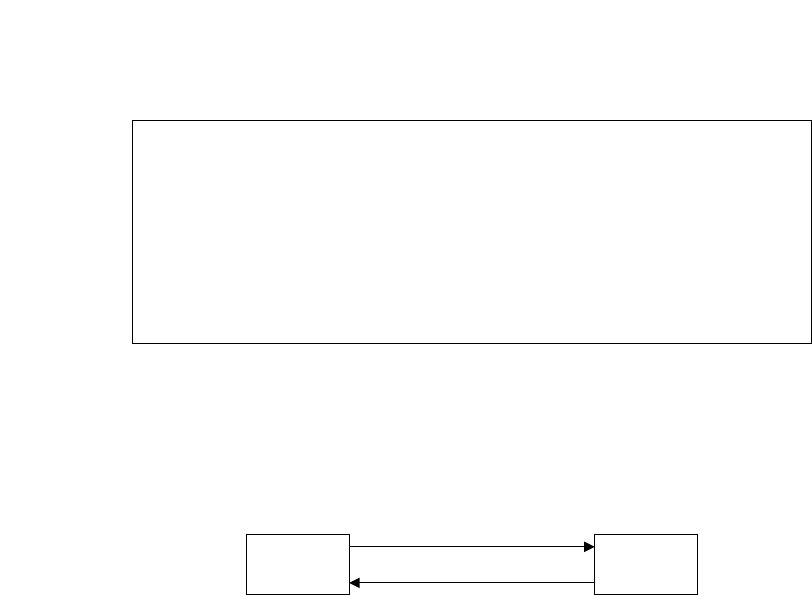Now let us consider what settlement would take place.
The formula used to calculate settlement is:
Notional Principal Amount (Fixed Rate LIBOR)
days in FRA period/days in year divided by
(1 (LIBOR days in FRA period/days in year))
Calculation
£5 000 000 (0.0725 0.075) 91/365 over
(1 (0.075 91/365)) £3 059.23
The LIBOR rate was higher than the fixed rate so the buyer (the
manufacturer) receives the difference from the seller, in this case a
quarter of one per cent on £5 000 000.
However, there is no exchange of the £5 million. The manufac-
turer will borrow the money from a lending source and the money
received from the FRA will offset the higher borrowing costs of around
7.5 per cent.
Had the LIBOR been lower than the fixed rate, the manufacturer
would have paid the difference to the seller but, of course, would
borrow the money at a lower rate.
The manufacturer ‘locked’ in a rate of 7.25 per cent for their
planned future borrowing.
As far as settlement is concerned, the amount due is known on the
settlement date, the date at which the FRA period starts (one-month
time) and the calculation period is known (three months).
Unlike most transactions that settle on maturity, an FRA can be
settled at the beginning of the calculation period. The amount is
present valued or discounted to reflect the interest that would
accrue if the amount paid was deposited to the end of the FRA
period.
Swaps
Swaps are products that as the title implies involve the swapping of
something. This can be, for instance, interest rates (an ‘interest rate
swap’ is abbreviated to IRS), currencies, equity benchmarks against
an interest rate or commodities.
98 Clearing and settlement of derivatives

Example
Interest Rate Swaps
An IRS would be an agreement to swap or exchange, over an agreed
period, two payment streams each calculated using a different type
of interest rate and based on the same notional principal amount.
The exchange of cash flows originating from, say, a fixed rate
and a floating rate would be called a ‘plain vanilla’ or ‘vanilla’ IRS.
By using swaps, a company can fix interest rates in advance for a
specific period, typically from 3 to 10 years but can be any duration
agreed by the two parties to the transaction.
Example:
OTC products 99
Settlement of an IRS takes place according to the agreed exchange
periods. Instead of buyer and seller, in the swap market reference is
made to the receiver and the payer.
For example, the receiver of the fixed rate is the payer of the floating
and, conversely, the receiver of the floating is the payer of the fixed.
Likewise the receiver of 3-month Floating is the payer of 6-month
Floating, where the flows to be exchanged are two different floating
rates, known as a basis swap.
During the life of the above swap (known as the Term) there will be
an exchange of the netted payment flows at payment date, calculated
at what is known as reset dates, i.e. semi-annually, annually and
valued against the benchmark rate(s).
The payments cannot be netted at each reset date if the payment
dates are different, i.e. the fixed is paid annually and the floating
semi-annually.
The IRS will be transacted to start at a forward date and will run for
the agreed period. The start date is known as the effective date and
the end date is known as the termination date.
The floating rate is reset at the effective date for the next period and
then at reset dates for the next period throughout the term of the swap.
Suppose a company, let us call it Company X, currently pays a float-
ing rate of interest, say LIBOR 0.4 per cent for a loan of $10 million
Fixed rate
Floating rate
Bank A /
Company X
Bank B /
Company Y

over five years. Concerned that rates will rise, the treasurer wants
to change the payment flow to a fixed rate but is unable to alter the
terms of the loan.
Company X approaches Bank B and agrees a five-year IRS the
terms of which are that:
Company X will pay 6.3 per cent fixed, paid annually on an actual/
360 basis, and receive LIBOR, semi-annually on an actual/360
basis.
At the beginning of the swap, LIBOR is 6 per cent. At the end of
the first six months the floating-rate payment is:
$10 000 000 6.00% 181/360 $301 667
which is paid by Bank B to Company X.
Note: There is no netted payment against the fixed rate flow for the
period as the terms state that the fixed rate settles annually.
At the beginning of the next six months LIBOR is 6.25 per cent
and after the six months the payments are:
Floating
$10 000 000 6.25% 184/360 $319 444
(due by Bank B to Company X)
Fixed
$10 000 000 6.30% 365/360 $638 750
(due from company X to Bank B)
This time the settlement can be netted so that Company X pays
$319 306 to Bank B.
In this IRS, Company X has a risk as their view on interest rates over
the next five years may be wrong and rates might actually fall, not
rise. By agreeing to pay a fixed rate, in this case 6.3 per cent, their
cost of borrowing may be much higher than it would have been if
they had not entered into the swap.
As an alternative strategy the treasurer may have entered into a
swaption. This is an option to enter into a swap. Like all options it
gives the treasurer the right, but not an obligation to enter into the
swap at some stage. As this is an OTC transaction, the precise terms
of the swaption and the cost of buying it will be negotiated.
100 Clearing and settlement of derivatives

Example
Currency Swap
A currency swap is an exchange of a series of cash flows in one
currency for a series of cash flows in another currency, at agreed
intervals over an agreed period, and based on interest rates.
It is possible to have a combination of fixed and floating rates in
two currencies in a currency swap.
Examples of the possible combinations are:
• Fixed interest in one currency to floating rate in another currency.
• Fixed interest in one currency to fixed interest in another.
• Floating rate in one currency to floating interest in another.
In a single currency IRS as illustrated above, there is no exchange
of the principal amount; however, with a currency swap there is usu-
ally an exchange of the principal amounts at the beginning and end
of the Term at a rate agreed at the beginning.
Remember this is an OTC transaction so a currency swap can have
an exchange of principal at the beginning or end or not at all if that
is what the two parties agree.
If, say, a UK company wants to expand business in the United
States by providing an influx of capital and it can borrow money
cheaper in the United Kingdom where it is well known to its bankers,
it can enter into a currency swap whereby: it can borrow British
Pounds (GBP) on a floating rate basis from its bank and swap the
GBP for dollars with the swap counterparty. It will agree to pay
a fixed rate of interest on the dollars and receive a floating rate of
interest on the GBP, which it uses to pay the interest on the original
GBP loan from its bank.
It agrees to exchange the principal amounts at the beginning at a
Foreign Exchange (FX) rate that is agreed and will therefore need to
fund the repayment of the loan, which is a totally separate transac-
tion from the swap of its own resources.
The dollars are given to the US business and the subsequent
income stream pays the interest on the dollars, which is paid to the
swap counterparty. As we have said the GBP interest received from
the swap counterparty pays the interest on the loan.
During the Term of the swap, which will correspond to the loan
duration, the payment streams will be settled on reset dates. They are
not netted because they are in different currencies.
OTC products 101
..................Content has been hidden....................
You can't read the all page of ebook, please click here login for view all page.
